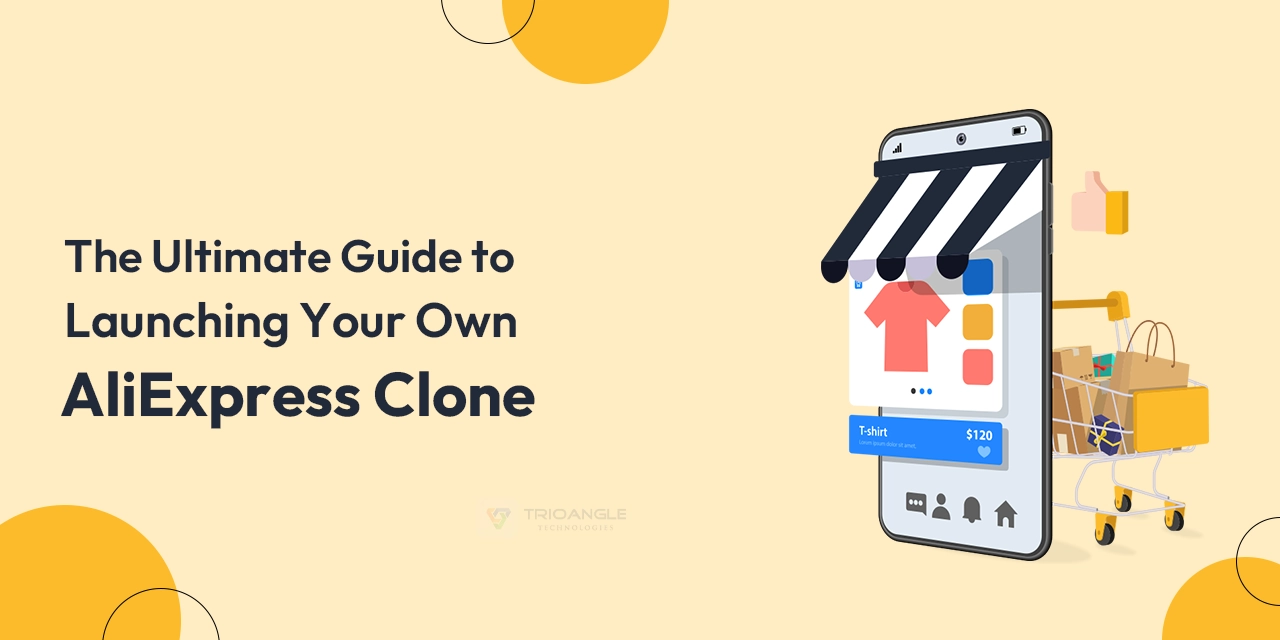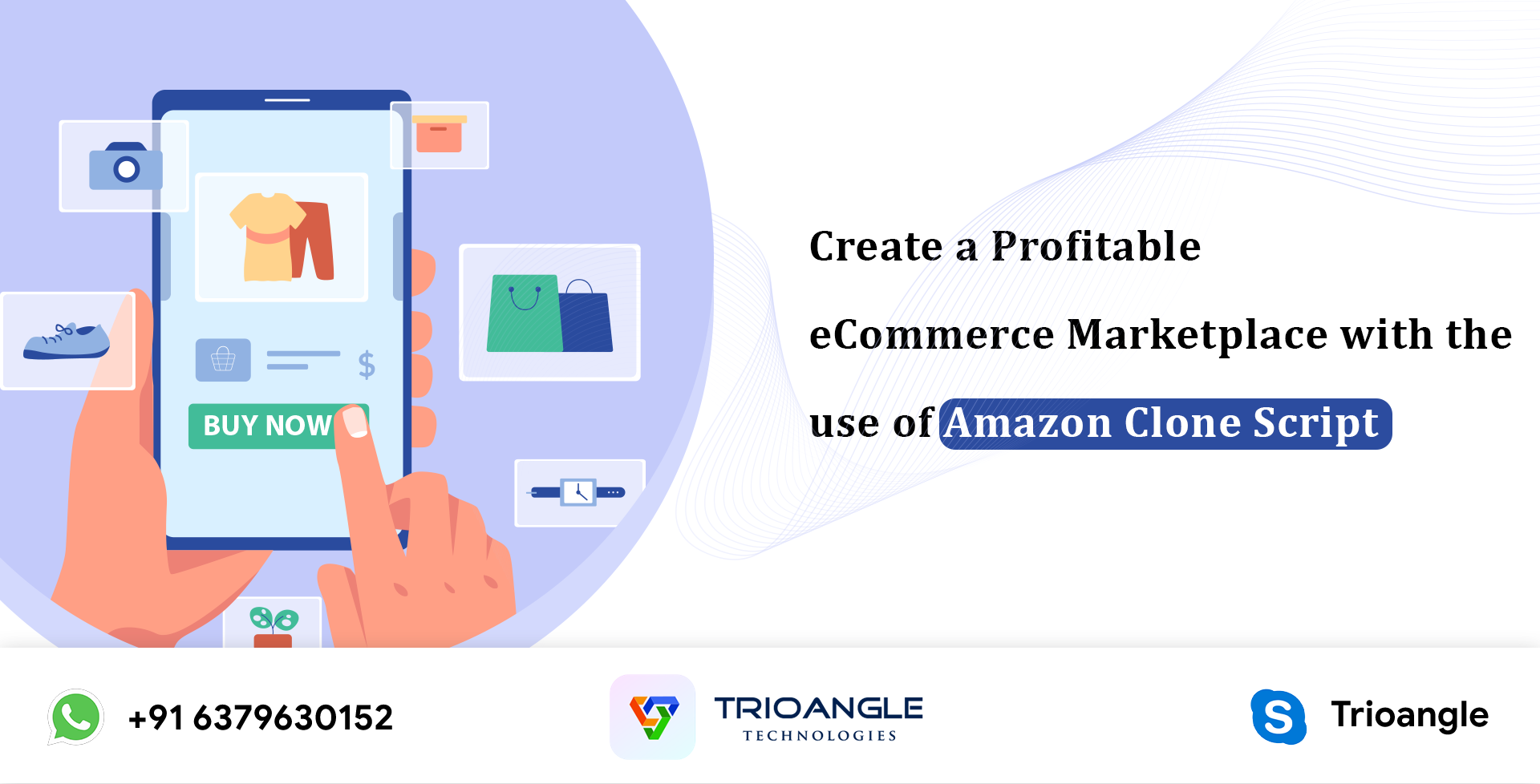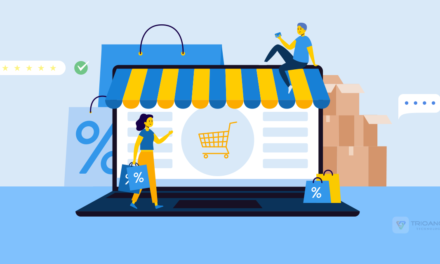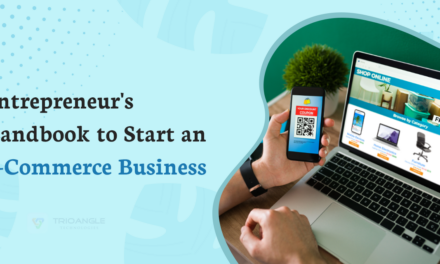Curious about how to create a thriving online marketplace like AliExpress? It’s not as hard as it sounds! This ultimate guide breaks down everything you need to launch your very own AliExpress clone, from the technical setup and design to attracting buyers and sellers.
Whether you’re just starting or looking to scale, this guide has got you covered. Ready to make your e-commerce dream a reality? Let’s dive in,
Key Takeaways:
Before you start developing your own AliExpress clone, here are some essential points to remember:
- An AliExpress clone connects buyers and sellers without holding inventory, making it a scalable business model with global reach.
- Essential features include secure payments, product search, seller dashboards, and order tracking.
- Revenue can come from commissions, ads, subscriptions, and logistics services. Building the platform requires careful planning, the right tech stack, and skilled developers.
- Start lean with a minimum viable product (MVP) to manage costs effectively. Testing is crucial to ensure smooth user experiences from sign-up to checkout.
What is an AliExpress clone?
An AliExpress clone is essentially a ready-made online marketplace that resembles and functions similarly to AliExpress. It enables businesses to quickly build their own e-commerce platform, on which various sellers can list products, and shoppers can easily explore and make purchases.
It saves a significant amount of development time and money, making it ideal for anyone looking to enter the thriving online retail industry without starting from scratch. Cool, right?
What makes an AliExpress clone a smart choice?
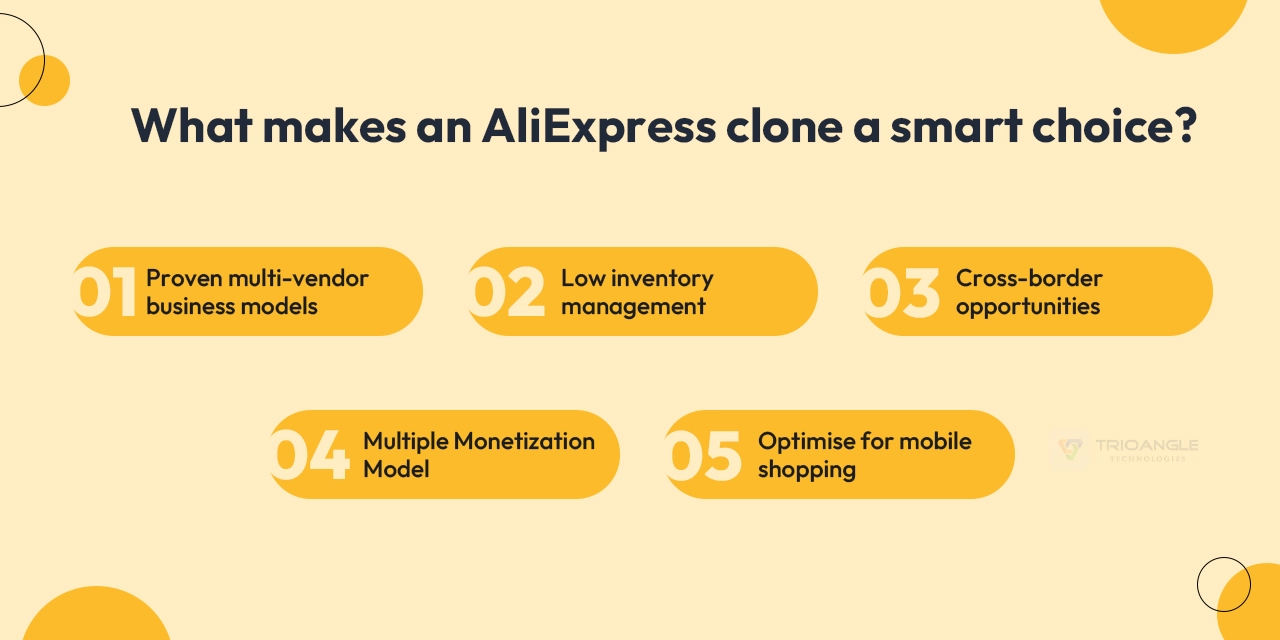
Do you know why an AliExpress clone is a smart choice for launching an e-commerce platform? Let’s discover it!
Choosing an AliExpress clone, a ready-made eCommerce platform based on AliExpress, can be a wise decision for entrepreneurs or businesses looking to develop a multi-vendor online marketplace. Here’s an explanation of why you would select an AliExpress clone
1. Proven multi-vendor business models:
AliExpress is a subsidiary of Alibaba that uses a commission-based multivendor model, allowing third-party merchants to list their products on the marketplace while the platform gets a fee on each transaction.
- AliExpress has over 150 million active users worldwide.
- There are over 100,000 vendors, each of whom is in charge of inventory and shipment.
- It operates in more than 230 countries, giving it a truly worldwide brand.
2. Low inventory management:
Unlike traditional eCommerce businesses that must manage stock and operate warehouses, an AliExpress clone significantly reduces inventory expenses, especially when dropshipping is implemented, which allows merchants to offer products without retaining real stock.
3. Cross-border opportunities:
AliExpress gained prominence through cross-border shopping, which connected Chinese sellers with consumers throughout the world. Your clone can use the same approach, concentrating on emerging areas in Africa, Southeast Asia, and Latin America, where online marketplaces are still expanding.
4. Multiple Monetization Model:
This is where things get interesting. Let’s talk about how you can actually earn revenue from your platform. Here are the built-in monetization strategies that make it happen.
- Subscription plans
- Seller commission
- Ads and sponsored listings
- Partnerships in logistics and shipping
- Affiliate programs
5. Optimise for mobile shopping:
Building a mobile-first AliExpress clone makes a lot of sense, given that approximately 73% of online shopping takes place on mobile devices. Using an app or a mobile web interface, you may provide customers with a seamless, simple, and satisfying buying experience
Yes, these reasons clearly show that an AliExpress clone is a smart choice for an e-commerce business. Now, let’s take a closer look at the core features of the AliExpress clone
Core Features of Aliexpress Clone:
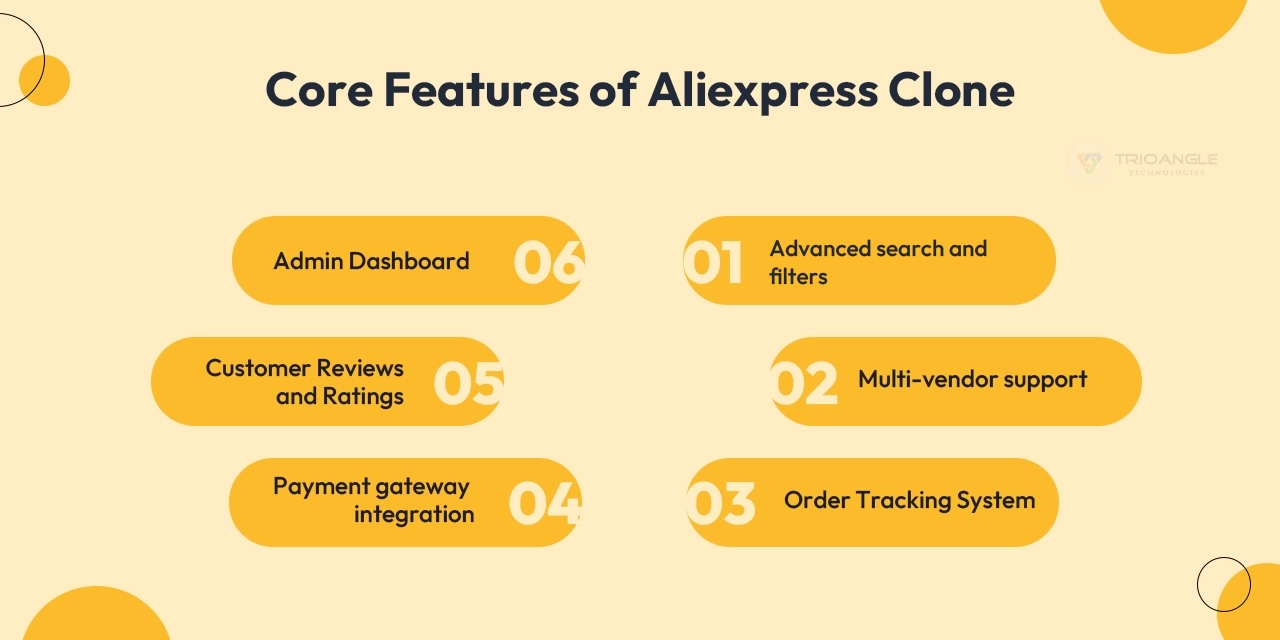
1. Advanced search and filters:
- Advanced search and filters allow you to quickly locate the products you desire by entering keywords and filtering results based on categories, price ranges, ratings, and other criteria. It makes shopping very easy and lets you find exactly what meets your needs quickly.
2. Multi-vendor support:
- Multiple vendors can register and develop their own stores on the site. Each vendor can individually manage their product listings, inventory, and orders, providing customers with a diverse range of products from many merchants in one convenient marketplace.
3. Order Tracking system:
- Buyers and sellers may stay up to date by tracking each step of an order, from processing to shipping and delivery. This feature promotes transparency and efficient communication, so everyone knows where the order is and when it will arrive.
4. Payment gateway integration:
- This functionality allows your platform to take a variety of payment methods, including credit cards, PayPal, digital wallets, and more. It makes paying simple and convenient for customers, allowing them to check out easily using their choice of payment.
5. Customer Reviews and Ratings:
- This feature allows buyers to offer honest feedback and rate products or merchants. It assists other consumers in making informed decisions and fosters trust, ensuring that everyone feels confident in their purchases on the platform.
6. Admin Dashboard:
- This feature gives the administrator complete control over user management, product approval, commission rate setting, and extensive reporting. It helps to keep the marketplace functioning smoothly and organized behind the scenes.
I think you’ve got a clear idea of what the core features are and why they’re important for an AliExpress clone app. It’s time to decode the steps involved in building the Aliexpress clone.
How to build an Aliexpress clone app
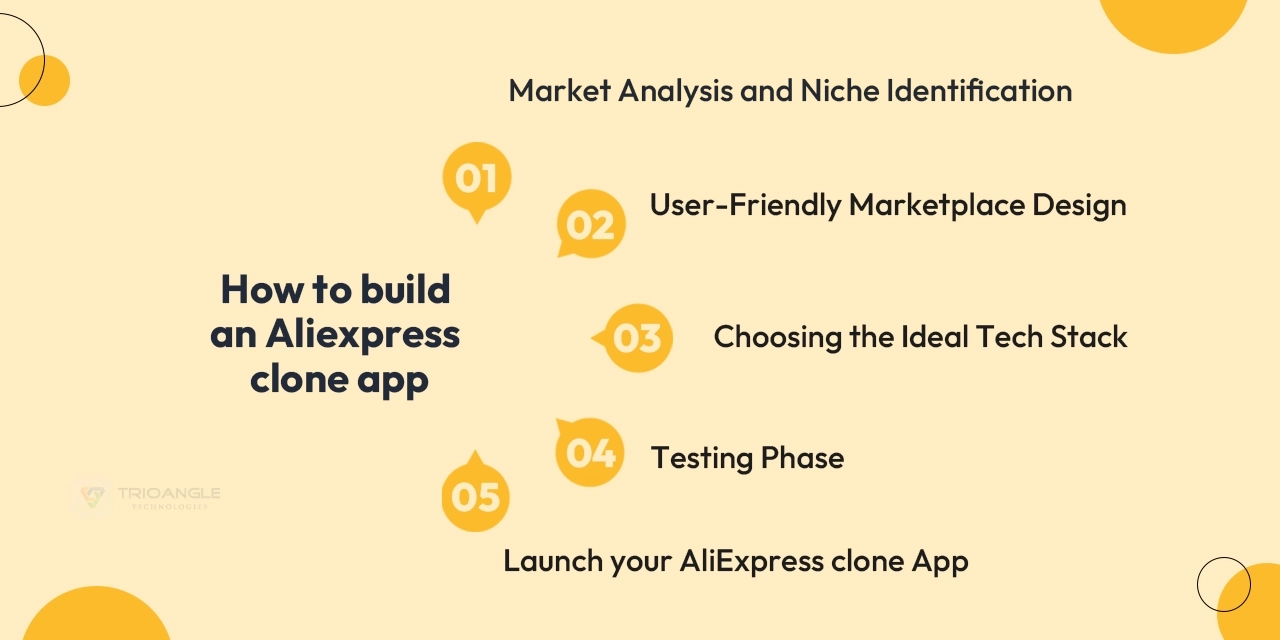
Step 1. Market Analysis and Niche Identification:
- Before launching your AliExpress clone, it is crucial to understand your clients’ ages, preferences, and buying behaviors. Understanding this allows you to tailor your platform, and as 70% of shoppers prefer personalized recommendations, knowing your target demographic can significantly increase your sales.
- Secondly, take a close look at your competitors in your niche or area to spot what they’re missing. Finding these gaps helps you discover valuable opportunities to stand out and grow your business by attracting more customers and meeting unmet needs.
- Finally, choosing the appropriate product categories for your clone requires knowing what your target audience actually wants. It’s about finding the right balance between customer demand and competitiveness to attract clients and build your business smoothly.
Step 2: User-Friendly Marketplace Design:
- Create a user-friendly interface that makes your AliExpress clone simple and comfortable to use. A modern, straightforward UI/UX allows customers to easily browse products while sellers can manage their shopfronts without hassle.
- It’s not only about looking attractive; everything should flow naturally. When your platform is simple to use, consumers trust it more, stay longer, and are more likely to return. A strong design can set the tone for your marketplace’s success
Step 3: Choosing the Ideal Tech Stack:
Are you feeling confused about choosing the right tech stack for your AliExpress-like app? Don’t worry, we’ve got you covered. Let’s explore the technologies that power a platform like AliExpress.
Frontend Technologies(client side):
- React.js: Popular JavaScript framework for creating dynamic and responsive user interfaces.
- HTML5, CSS3: For structuring and designing web pages so they look excellent on all devices
- React Native or Flutter: For developing cross-platform mobile apps (iOS and Android) that provide a seamless purchasing experience.
Backend Technologies(server side):
- Node.js (Express) or PHP (Laravel): It is widely used to manage server-side logic, user authentication, order processing, and vendor administration.
- Python (Django): Offers scalable, secure backend development with built-in capabilities for efficiently managing items, users, and orders.
Database(Data storage):
- MySQL or PostgreSQL: Reliable relational databases for storing product details, user information, orders, and transactions.
- MongoDB: A NoSQL database that is beneficial for data structure flexibility, particularly for big and diverse product catalogs.
Integration With External Third Parties:
- Payment Gateways: PayPal, Stripe, credit card processors, and digital wallets are all integrated to ensure smooth transactions.
- Shipping API’s: Connect to courier services such as FedEx, DHL, or UPS to get real-time delivery rates and tracking.
- Third Party Service: Email services (e.g., SendGrid), SMS notifications, analytics tools, and marketing platforms are used to improve the user experience.
Hosting:
- AWS S3: offers highly scalable and secure cloud storage for product photos and media files, allowing for effective processing of massive amounts of data while maintaining fast and reliable access.
Step 4: Testing Phase:
Once development is done, it’s time to jump into the testing phase. Here, you really find out if your clone app is running smoothly or if there are any hiccups to fix.
- Testing and Quality Assurance are vital to ensure your AliExpress clone runs smoothly and offers a great user experience. Begin with unit testing to verify individual features, then conduct integration testing to ensure all parts work together seamlessly. Don’t skip usability testing; observe real users to spot issues.
- Focus on key flows like sign-up, adding to cart, payments, and order tracking. Thorough testing builds trust, prevents costly errors, improves satisfaction, and creates a polished platform that keeps customers returning
Step 5: Launch your AliExpress clone App:
You’ve done the planning, building, and testing; now comes the big moment: launch, and this is the final step of the AliExpress-like app.
- After thorough testing, it’s time to take your platform live. Deploy your application to a reliable hosting environment, ensuring all systems are stable, and double-check that the core features work properly.
- Make sure that the website is secure, loads quickly, and performs properly on all devices. A successful launch not only increases credibility but also provides the framework for future growth as more individuals join your platform.
Building your own AliExpress clone isn’t as big a task as you might think. Just follow these 5 straightforward steps, and once you’re done, you can launch your platform and get a head start on the competition. Simple as that!
Also read: 6 Tips to Follow to Build a B2B e-commerce script
How much does it cost to build an AliExpress-like app?
I think now’s the perfect moment to dive into the cost, and to keep things simple, we can break it down into three stages: basic, intermediate, and advanced.
Basic Features ( MVP):
- Priced between $40,000 and $60,000, it includes product listing, user registration, basic search, and simple payment integration..
Intermediate:
- Priced between $100,000 and $250,000+.adds advanced search, seller profiles, multi-language support, reviews, order management, and better payment options.
Advanced Features:
- Price ranges from $250,000 to $500,000+; this package contains all intermediate capabilities as well as AI-powered product suggestions, thorough seller analytics, and multi-currency integration.
What impacts the AliExpress-like app cost?
Alright, now that we’ve broken down the cost of building the platform, let’s talk about the key factors that really impact the price.
- The cost for building an AliExpress clone is highly dependent on a few important elements. Adding key features such as multi-vendor compatibility, payment gateways, and real-time tracking will undoubtedly raise the price. Custom designs typically cost more than ready-made templates, and your technology stack affects both development time and overall costs.
- The location of your developers, whether in the United States, Eastern Europe, or Asia, has an impact on their hourly rates. You should also budget for additional costs such as third-party integrations, extensive testing, and continuing maintenance after launch.
How does an AliExpress clone make money?
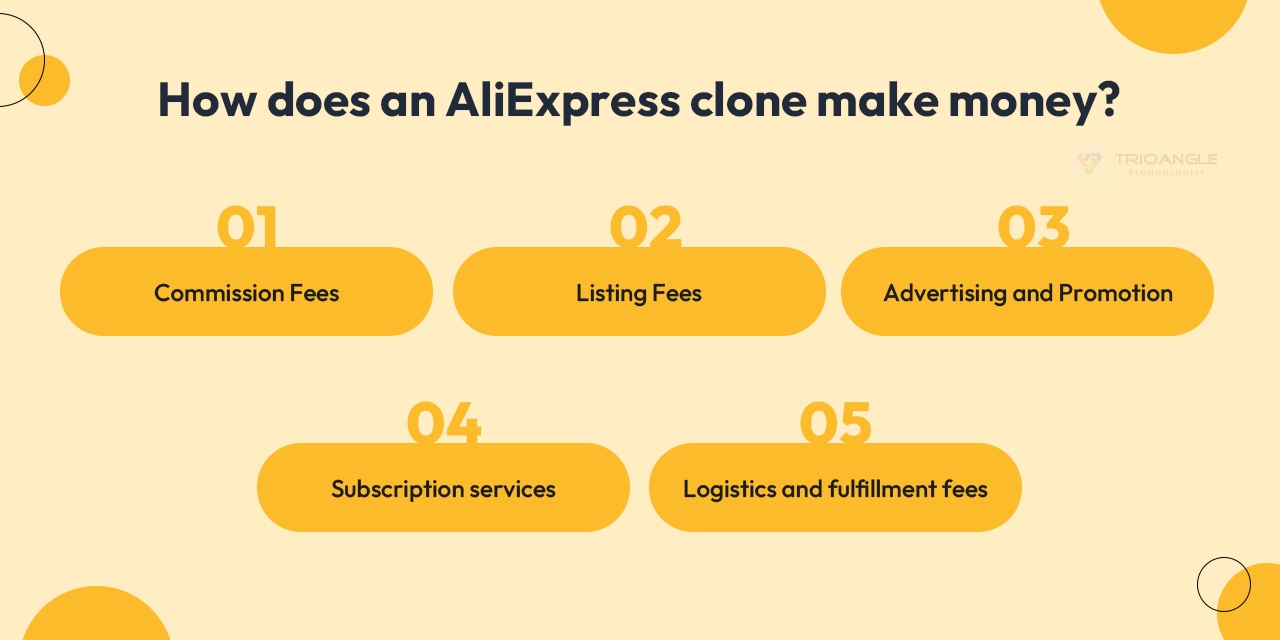
Wanna explore the different ways this clone platform earns its revenue? Here’s what you need to know.
1. Commission Fees:
- The major source of revenue for an AliExpress clone is commission fees. Basically, if a seller makes a transaction on the platform, the marketplace charges a small portion of the sale as a fee. It’s a situation in which the platform gets cash, while vendors gain access to a vast customer base.
2. Listing Fees:
- Sellers pay listing fees to place their products for sale on the platform. If sellers wish to increase their chances of getting their products recognized sooner, they can pay a small fee to have their listings promoted or highlighted. It helps the sellers stand out while also giving the platform a small push. Pretty sensible, right?
3. Advertising and Promotion:
- Advertising and promotions allow sellers to increase product visibility by paying for premium positioning or featured features. It’s like giving their products a little additional push to attract buyers’ attention faster.
- This not only helps retailers increase sales, but it also helps the platform generate more revenue. Everyone benefits from this smart setup!
4. Subscription services:
- Subscription services allow customers to pay monthly for benefits such as faster shipping, exclusive discounts, and special promotions. These perks make purchasing easier and more rewarding,
- while also providing the platform with consistent, recurring revenue. It’s a win-win situation that promotes continued business growth and keeps customers satisfied.
5. Logistics and fulfillment fees:
- Sellers and buyers pay for order management, packing, and shipping, particularly when sending internationally. The platform can charge a small fee or provide premium services such as speedier delivery or storage.
- These fees are typically structured as fixed per-order prices, delivery assurances, or warehousing fees.
Ending Note:
Launching an AliExpress clone is a wise decision after you grasp its primary features, revenue model, and development costs. This blog will take you through all you need to know to create a seamless, user-friendly marketplace. With the appropriate approach and planning, you can attract buyers and sellers, positioning your platform for long-term success.
Are You Ready to Launch Your Own Aliexpress clone App?

